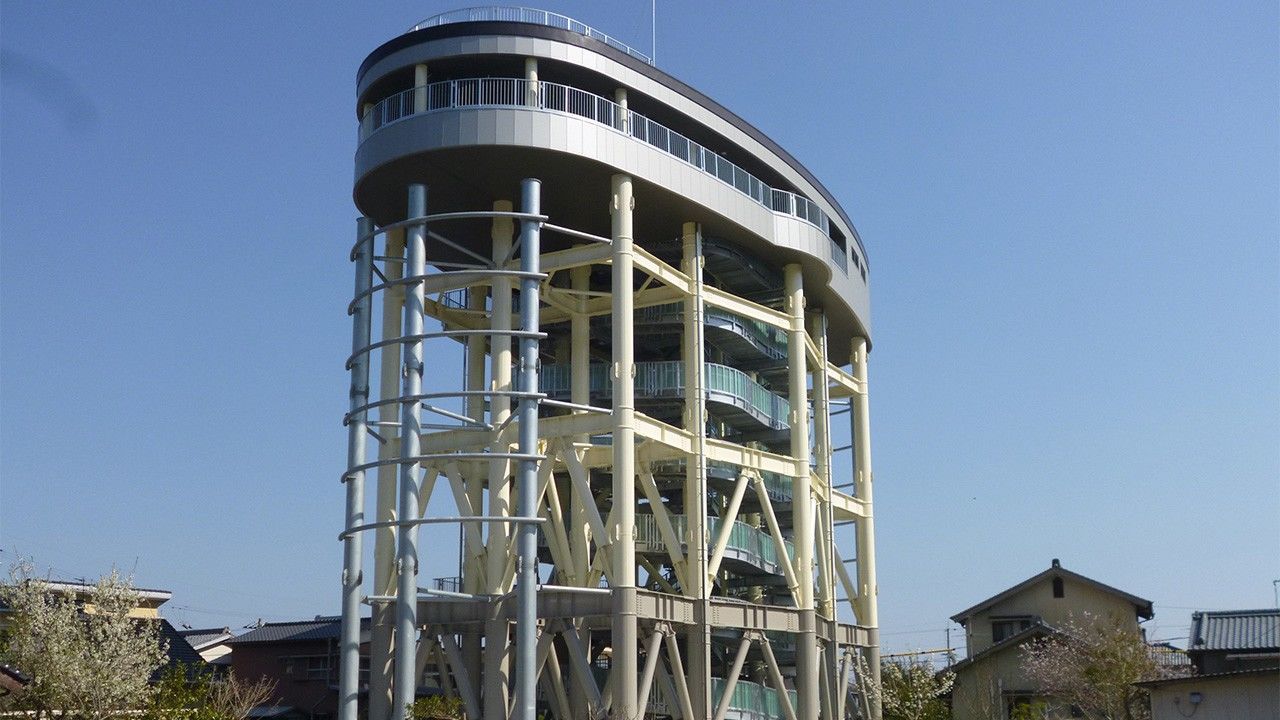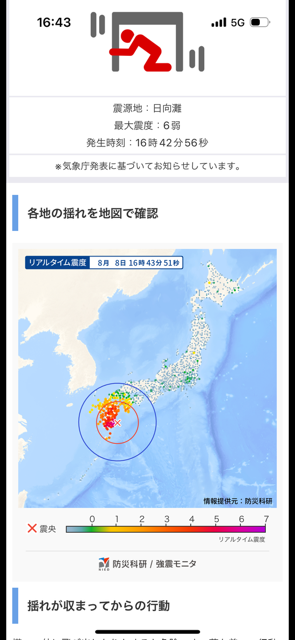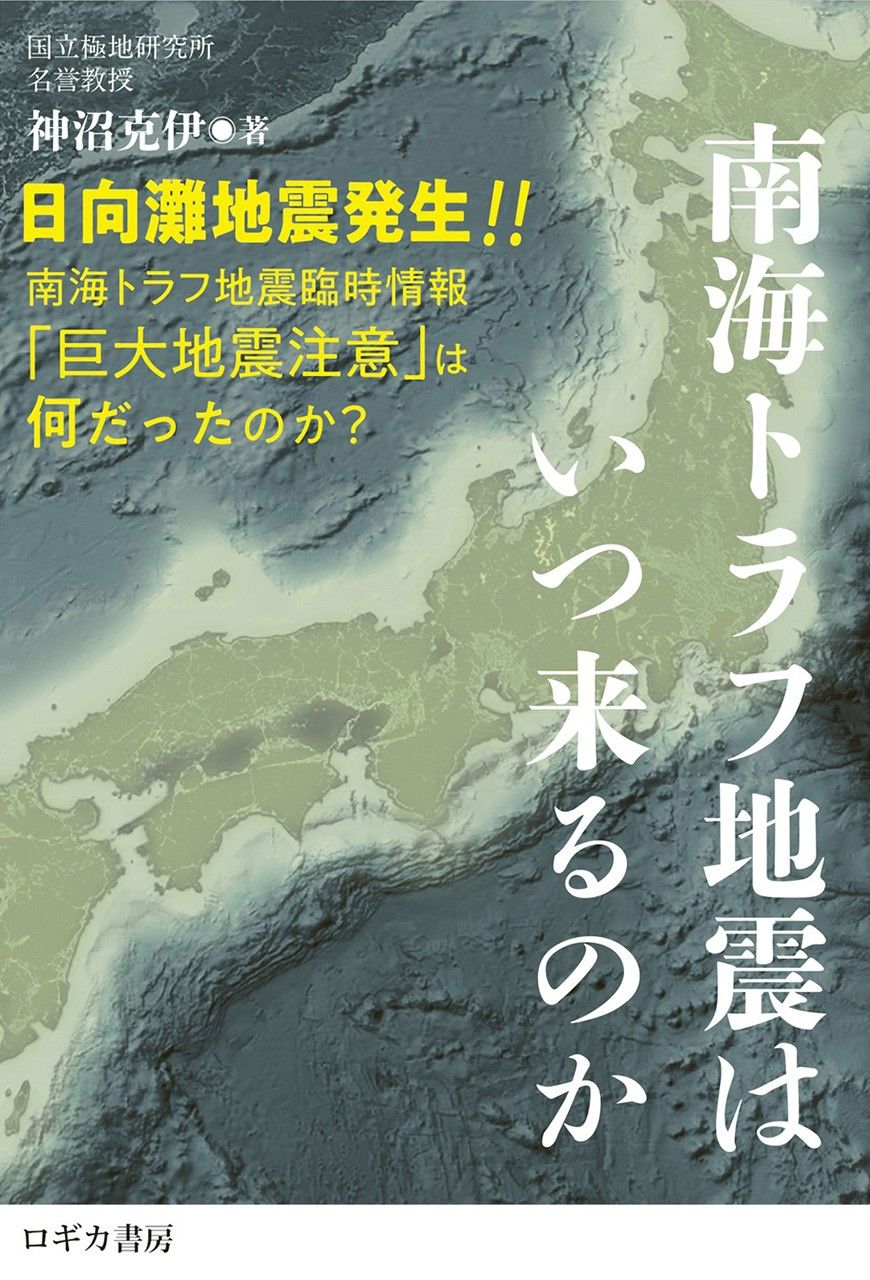
Rethinking the Nankai Trough Threat: The Importance of Earthquake Resilience
Books Disaster Society- English
- 日本語
- 简体字
- 繁體字
- Français
- Español
- العربية
- Русский
“Massive” Earthquake Warning Raises Eyebrows

A screenshot of the warning that appeared on my cellphone during the Kōchi earthquake. (Courtesy Izumi Nobumichi)
I was in the city of Kōchi on August 8, 2024, when at 4:43 pm, my cellphone sounded an earthquake warning earthquake alarm. Moments later, the ground started shaking. On this day, Kōchi was hit by a magnitude 7.1 earthquake centered in the Hyūga Sea.
At 7:15 pm, the Japan Meteorological Agency responded by issuing a “massive” earthquake warning for the Nankai Trough. The JMA and the Cabinet Secretariat urged those in the area to remain extra vigilant for the following week. Affecting 707 local administrations in 29 prefectures, chiefly on western Japan’s Pacific seaboard, the warning came as the region experienced extreme summer temperatures. Train services, including the Tōkaidō Shinkansen, were cancelled, beaches were closed due to tsunami risk, and events were cancelled or postponed as locals hoarded water and emergency rations.
The August warning was the first issued by the Japanese government for the Nankai Trough since the current warning system was introduced in 2019.
In Nankai torafu jishin wa itsu kuru no ka (When Will the Nankai Trough Earthquake Hit?), author Kaminuma Katsutada writes that “local governments and residents didn’t know what to do” after the August warning. Kaminuma criticizes the decision to issue the warning, which he describes as a more or less pointless exercise that should not be repeated.
What makes this book unique is the way it addresses the misgivings harbored by many in Japan who felt that there was something not right about the August warning, and gives advice on preparing for natural disasters.
Cautions Versus Predictions
The term “Nankai Trough earthquake” refers to any earthquake centered in the oceanic trough that extends from Suruga Bay south of Mount Fuji past the Kii Peninsula and the Shikoku coast to the Hyūga Sea southeast of Kyūshū. The alert issued by the Meteorological Agency in August was not an earthquake prediction. Rather, it was an alert that is issued whenever irregular activity is observed along the Nankai Trough or the earthquake risk is otherwise judged to be elevated. When issuing this alert, the JMA applies the following process.
First, when the Agency records an earthquake with a magnitude of 6.8 or above within the Nankai Trough earthquake zone, it issues an “under review” earthquake alert. It then promptly calls a meeting of experts to assess the risk of a massive earthquake. If the committee deems that there is an impending danger, it issues a “massive earthquake” alert or warning, while if the committee decides that the risk level is not elevated, it changes the alert status to “review complete.”
After the August 8 quake, it was this process that led the JMA to issue a “massive earthquake” warning. “There is a relatively high likelihood of a major earthquake,” read the statement, before awkwardly going on to say, “this does not guarantee that an earthquake will take place during the designated time period.”
“So which is it?” was the reaction of many residents and businesses in the affected areas. Kaminuma observes that the warning issued in August created confusion because it conflated events that occur within our lifetimes with those happening on a geologic time scale.
Next Quake Likely After 2045
Japan has experienced many of what are currently referred to as Nankai earthquakes over the years, although these have sometimes been called Tōkai or Tōnankai quakes instead—labeling them as taking place in the “eastern sea”or “southeastern sea” off of the main Japanese islands, rather than the “southern sea.” There were nine such earthquakes between the 684 Nankai/Tōnankai earthquake (also called the Hakuhō earthquake, after the name of the historical period during which it took place) and the 1946 Shōwa Nankai earthquake. Since the fourteenth century, Nankai earthquakes have generally occurred every 100 to 150 years. This means that massive earthquakes have been observed in living memory—within the span of a human lifetime, or by previous generations who can pass down tales of the disasters.
While the Hyūga Sea is an earthquake-prone stretch of water, there has never been an instance of a tremor under this body of water triggering a massive quake along the Nankai Trough. In fact, the Hyūga Sea was not originally part of the zone used to predict Nankai Trough earthquakes. However, after the Great East Japan Earthquake and tsunami of March 2011, whose magnitude of 9.0 far exceeded the previously assumed worst-case scenario, the authorities decided to “take into account all possibilities” when predicting the most massive earthquake/tsunami that could affect the Nankai Trough. The epicenter zone used by the current model is based on a geologic time scale that involves historical plate movements and geological phenomena that occurred before humans were on the earth. This led to the enlargement of the assumed epicenter zone to include the Hyūga Sea on its west flank.
On January 15, 2025, the Japanese government’s earthquake research committee published its predictions for the likelihood of earthquakes in and around the Japanese archipelago, stating that there was an “around 80%” chance of a massive earthquake centered in the Nankai Trough within the next 30 years. This contrasts with Kaminuma’s prediction on timing:
The time frame is definitely 2045 to 2095, or thereabouts. This date range for the next massive earthquake is based on a human lifespan. On this basis, the massive earthquake warning issued in 2024 was farcically early, and of no use to anyone.
Incidentally, on the night of 13 January, Shikoku was again hit by a magnitude 6.6 earthquake centered in the Hyūga Sea that recorded a maximum seismic intensity of 5 lower on the JMA Seismic Intensity Scale. While the Meteorological Agency again issued an “under review” alert, the committee later judged that the event did not warrant a caution or notification, and updated the status to “review complete.”
Earthquake Resistance Dictates Survival
Kaminuma Katsutada was born in 1937 and holds a doctorate in solid earth geophysics from the University of Tokyo. An honorary lecturer at the National Institute of Polar Research, Kaminuma has visited the South Pole as part of Japanese government expeditions 16 times. He says that his experience working at the University of Tokyo’s Earthquake Research Institute and the Kirishima Volcano Observatory since the early 1970s always made him particularly aware earthquakes in the Hyūga Sea.
A true quake expert, Kaminuma advocates “earthquake resilience”—a reference to a process of learning earthquake survival skills. Earthquake resilience is all about simulation: From time to time, at random times in random places, we should ask ourselves, “What would I do if there was an earthquake now?” he says. The book also includes an earthquake resistance scorecard that allows readers to assess their own preparedness.
In earthquake-prone Japan, you never know when the “big one” could hit. When Will the Nankai Trough Earthquake Hit? is a useful preparation tool, as it contains extensive information and suggestions for keeping safe. The 12 side-articles interspersed throughout the book also contain useful earthquake facts, and show the insight you would expect from an 88-year old academic who has spent his life researching the earth.
Published by Logica Shobō in 2025
ISBN: 978-4-911064-19-1
(Originally published in Japanese. Banner photo: An evacuation tower in the town of Kuroshio, Kōchi, was completed in 2017 to give local residents a way to escape tsunami following a massive earthquake. Courtesy Kuroshio municipal government; © Jiji.)


